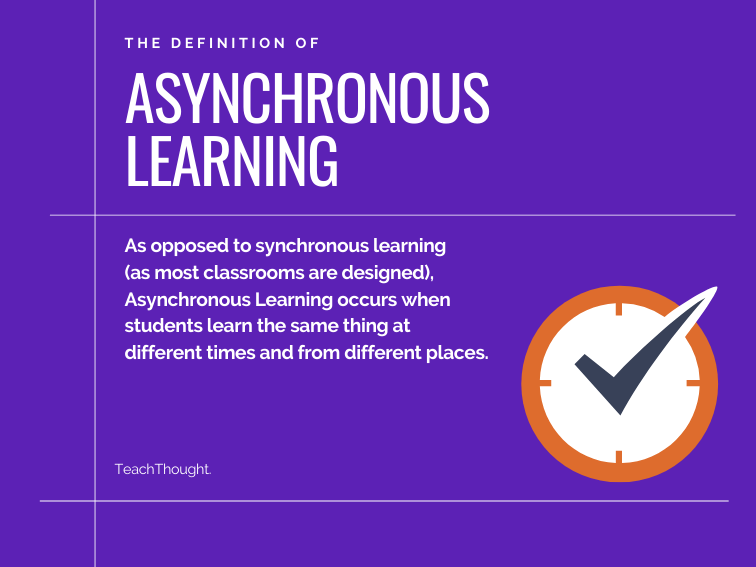
What Is Asynchronous Learning?
by Terry Heick
Simply put, asynchronous learning occurs when students learn the same thing at different times and from different places.
There’s obviously a lot more to it and many underlying assumptions even in the definition above. But in an effort to keep things simple for now, let’s assume that we’re talking about a formal, academic, standards-based K-12 or university learning environment where there is a common curriculum of some kind.
One way to understand asynchronous learning is in contrast–that is, what it’s not. And in this case, it is the opposite of the ‘synchronous’ learning that takes place in most classrooms around the world today.
This traditional approach to education sees one teacher package a standardized curriculum into individual lessons and units. The lessons are delivered in-person (though sometimes in a blended learning or flipped classroom approach where physical and digital learning are mixed) to the entire class at once, usually through a combination of direct instruction, group activities, and teaching/literacy strategies.
Asynchronous learning breaks all of this into blocks and requires students to build meaning on their own. Obviously, this necessitates some adjustments (more on that in a separate post).
The Characteristics Of Asynchronous Learning
The primary characteristic of asynchronous learning is that it is more or less ‘untethered’ from typical constraints. That is, it is not dictated by time, place, or collaboration. While there are always exceptions and variations, this overarching theme of independence significantly changes the process of learning.
One analogy? Synchronous learning is like a yoga class while asynchronous learning is like someone listing all of the poses ahead of time, providing you with resources to practice and learn those same poses on your own.
Another analogy to help explain the definition of asynchronous learning could be attending a luncheon and being served the same meal everyone else is being served at the same time, while asynchronous learning is like a large buffet of the same (or similar) ingredients that you can go and serve yourself when and how you please.
A final, simpler analogy? Synchronous learning is like network television while asynchronous learning is like Netflix. (Binge-learn away.)
In asynchronous learning, students access content without respect to (or with reduced dependence on) their peers. The role of the teacher is different as well (more on that soon) but one effect is reduced access to a teacher in ‘real-time,’ and thus reduced dependence on that teacher.
The pace of the learning is less tied to curriculum layouts, pacing guides, and even the sequence of the curriculum itself can be unique. This isn’t to say that it’s unsupported altogether. There are many types of blended learning and many types of project-based learning, and there is no single form of asynchronous learning, either. It just means, ‘different times and from different places.’
Or even more simply, learning ‘not together.’
This means that differentiation is more natural–less disruptive to the ‘rest of the class’ and less demanding of the teacher as there is no ‘real-time’ teaching.
Most commonly, asynchronous learning is an approach to education where students learn the same content from different (geographic) places and at different times.
A Few Other Facts
The majority of the work for teachers in this style of learning is ‘up front’–that is, in the development of online courses, eLearning materials, documents and materials, communication tools to communicate with students, asynchronous learning-friendly curriculum, and more.
How much work there is ‘after’ learning depends on the nature of that specific asynchronous learning circumstance–whether it supported like a university course or unsupported like a MOOC, etc.
The definition of synchronous learning can meet the definition of blended learning but the former is generally digitally-based. (Imagine a physical classroom that attempted to facilitate students learning the same content at different times. In most cases, this wouldn’t make much sense.)
The Flipped Classroom model is an approach to learning with some elements of being asynchronous–again, it just depends on how it is designed and used. In that way, it can meet the definition of asynchronous without meeting every one of its criteria.
Asynchronous learning is generally technology-intensive and depends on students and teachers to both have access to and expertise with those tools. Poorly done, asynchronous learning is little more than someone taking lessons often designed for in-person delivery, then posting them ‘online’ for students to access. Throw in a quiz and a ‘report’ and–well, the learning was asynchronous but at what cost? And what exactly was the gain? Like every other approach to learning, it must be designed for with its strengths and limitations in mind.
